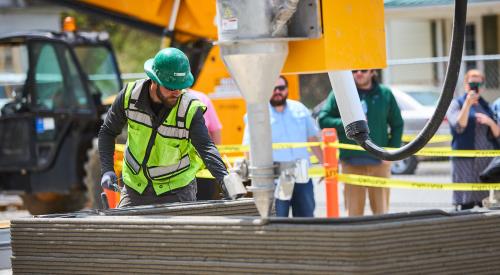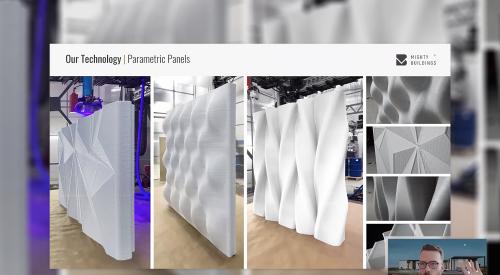The 3D Printed Housing Conference brought together a slew of industry experts to discuss the past, present, and future of 3D construction printing (3DCP). With presentations from Black Buffalo, Mighty Buildings, and more, innovative ideas were aplenty.
One of those ideas? Education. From companies looking to create training programs, to advancing industry knowledge through university partnerships, here are some of the experts’ takes:
CREATING THE 3D PRINTING WORKFORCE
3D printing technology is reducing the workforce for framers through machine automation. Zack Mannheimer, CEO of Alquist 3D, believes in the need for creating more jobs than are being replaced.
Alquist has created an eight-week certificate program in 3DCP, offered to community colleges and high schools in all of the regions they’re currently printing.
Currently, Alquist’s courses are planned to be offered at Thomas Nelson Community College in Williamsburg, Va., and Wilkes Community College in Wilkesboro, N.C.
It’s Alquist’s hope that by bringing more people into the 3DCP workforce, the cost of 3D printed housing will drop. In the meantime, what are some other ways we can advance the industry through academia?
BENEFITS OF PARTNERING WITH UNIVERSITIES
Dr. Theo Salet is the dean of the Department of the Built Environment at Eindhoven University of Technology. He has a unique perspective of the 3DCP world given his research of concrete, systems, and design.
Salet and his students research advanced 3D printed construction techniques as well as work with local groups to 3D print structures in the Netherlands. Over in Europe, this is supported by a close collaboration among universities, the industry, and government.
One advantage of partnering with universities is that, unlike businesses, they’re not trying to sell a product or develop a system. Universities have the goal of understanding the systems that make 3DCP possible, bringing knowledge to the industry for further development.
So, let’s say you find a preferable university that you’d like to partner with. Now what? Salet has some advice:
“The company that has the idea to team up with a university should be really willing to not only innovate themselves, but to look beyond the borders for knowledge that is not available yet,” he says.
A great partnership comes from the company expressing its clear interest in the industry. Do you want to innovate with aggregates? Find a better way to print affordable housing? Whether your goal as a company is to increase profit margins within the next year, or advance industry-wide technology in four, the distinction must be made for a successful university partnership to happen.
Salet suggests having these discussions with universities, allowing for both parties to have a clear understanding of the potential partnership. According to Salet, the universities will raise all of the ‘why’ questions to the company, and then come up with a profile to discover unknown knowledge.
As Salet has found, a close collaboration between universities and industrial partners allows new knowledge to be brought into real-world practice. However, he also acknowledges that a successful partnership cannot be started without one thing: money.
“That’s always the elephant in the room,” he says. “The truth is that most of the time, money can be found. There’s a lot of funding to do research, so universities and companies can team up to find funding.”
In the end, a company can also go to its local government and start the discussion with them. What is your agenda? What is the local government’s agenda? Once starting a discussion, Salet says, you’ll easily find a match.
To get access to the full clips from the 3D Printed Housing Conference, click here to watch them for free.















